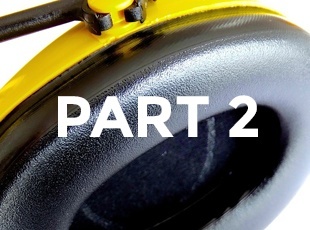In part one of our hearing protection series, we shared with you how the ear works, how decibels are measured, and how loud equipment is in the workplace. Today, we would like to share with you the controls to reduce exposure, as well as the different types of hearing protection available, including pros and cons of each.
Engineering and Administrative Controls
To protect workers from exposure to any workplace hazard, employers are urged to implement controls before use of hearing protection equipment.
Engineering Controls
The first step to minimize exposure to hazards in the workplace is to implement engineering controls to reduce sound levels created by machinery or equipment. Engineering controls involve modifying or replacing equipment, or making related physical changes at the noise source or along the transmission path to reduce the noise level at the worker’s ear.
Examples of inexpensive, effective engineering controls include some of the following:
- Choose low-noise tools and machinery (e.g., Buy Quiet Roadmap (NASA)).
- Maintain and lubricate machinery and equipment (e.g., oil bearings).
- Place a barrier between the noise source and employee (e.g., sound walls or curtains).
- Enclose or isolate the noise source.
Administrative Controls
Administrative controls are changes in the workplace that reduce or eliminate the worker exposure to noise. Examples include:
- Operating noisy machines during shifts when fewer people are exposed.
- Limiting the amount of time a person spends at a noise source.
- Providing quiet areas where workers can gain relief from hazardous noise sources (e.g., construct a sound proof room where workers’ hearing can recover – depending upon their individual noise level and duration of exposure, and time spent in the quiet area).
- Restricting worker presence to a suitable distance away from noisy equipment.
Controlling noise exposure through distance is often an effective, yet simple and inexpensive administrative control.
Increasing the distance between the noise source and the worker, reduces their exposure. In open space, for every doubling of the distance between the source of noise and the worker, the noise is decreased by 6 dBA.
For more information, view the following resources:
- NIOSH Recommendations on Preventing Hearing Loss [Full Text]
- OSHA Noise Hearing Conservation Page
- 29 CFR 1910.95 Occupational Noise Exposure
Earplugs and Hearing Protection Devices
If you cannot take steps to reduce the amount of noise the machinery makes, or reduce the amount of time an employee is exposed to sounds that could cause damage to his or her hearing, the next plausible step for employers and managers is the supply, facilitation, and enforcement of hearing protection.
The final way to minimize exposure is to provide hearing protection devices to employees. It is important to remember that hearing protectors only reduce the amount of noise that gets through to the ears. EHS Today provided a detailed table to break down the pros and cons of each type of hearing protection that exists.
Earplugs
| Type | Pros | Cons |
| Foam, Disposable Earplug |
|
|
| Multi-use earplug |
|
|
| Push-in foam earplug |
|
|
| Custom earplug |
|
|
| Banded earplug |
|
|
Hearing Protection Devices
| Type | Pros | Cons |
| Amplification HPD |
|
|
| Uniform attenuation HPD |
|
|
| Non-linear HPD |
|
|
| Intelligent HPD |
|
|
A Hearing Protection Program Fits into a Complete Safety Management System
Being able to recognize and mitigate hazards, including hearing, is a necessity for organizations looking to recognize their return on safety—the productivity, engagement and profitability that comes with an effective safety management system.
Optimum Safety Management will not only provide your company insight into its safety management system as it exists now using our 30 point gap analysis, but also tell you what you can do to make it better.
Learn more about the five necessities of an effective safety management system here, and contact us when you’re ready to realize your full Return on Safety™.








